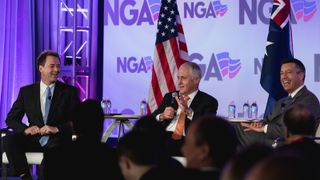The National Governors Association (NGA) Winter Meeting was held over the weekend and, as reported, was addressed by Prime Minister Malcolm Turnbull. During his speech he touched on our shared military history with the United States, as well as the importance of innovation to both our economies.
Turnbull has been relatively quiet on the topic of innovation since the last election, and yet his speech clearly articulated that innovation and science are key elements in our economic strategy as the key to productivity, enabling economic growth and more and better paid jobs.

US governors are likewise focused on innovation with the current NGA chair and Nevada Governor Brian Sandoval’s chosen theme for his term being technology innovation. The ‘Ahead of the Curve: Innovation Governors’ initiative is examining six ways in which governors can help citizens, businesses and public sector prepare for the technical transformation of the economy; supporting technology transformation, modernise policy and regulatory processes, prepare and educate the workforce, update communications and data systems, protect systems from data threats and inform citizens about benefits and risks.
In keeping with this theme, across the weekend governors took part in discussions about the future of food and agriculture, the opioid crisis, innovation in higher education, caring for veterans and the future of work. They heard from a range of public and private sector leaders, and had the opportunity to share information and ideas.
Australia’s focus on getting STEM skills into schools is commendable, however our private sector could learn a lot from the United States as it looks to deal with the uncomfortable reality of the impact of technology on our workplaces.
Bright spots in the agenda were the focus on education, training and the future of work. Guests including Ginni Rometty, CEO of IBM, Brad Smith, president of Microsoft, and Kathleen McLaughlin, president of the Walmart Foundation, shared their experience of moving towards the workplaces of the future, addressing current talent shortages and the retraining of mid-career workers.
This is the immense challenge facing both Australia and the United States in the medium term, as jobs change in response to automation, artificial intelligence and technological disruption. Several themes flowed throughout these discussions, including the need to move workers and organisations towards life-long learning, and the recognition that while more than half future workers in the United States won’t get a four-year degree, many can still train for what IBM's Ginni Rometty calls ‘new collar’ jobs. There was much discussion about new apprenticeships and examples of programs bringing together high school and higher education (via community college) to train young people in the skills valued in the economy so that when they graduate they are going into jobs earning double the median salary.
IBM is spending $500m per year in retraining, and have transitioned mid-career workers into cybersecurity jobs from fields such as retail, education, entertainment and law. Indeed 20 per cent of IBM’s hiring in cybersecurity since 2015 has been made up of ‘new collar’ professionals. There was much discussion among the governors about how to enable potentially displaced workers to transition into skills shortage fields and it was interesting to hear how US private sector companies, such as IBM, Walmart, Starbucks and Microsoft, are leading the way.
However, with 16 US states not allowing computer science to count for a core mathematics or science requirement for high school graduation, it seems Australia’s national curriculum – with the inclusion of computational thinking from foundation years (kindergarten/prep) – is better preparing students for the future. A future where predictions are that 65 per cent of children starting primary school this year are going to be working in jobs that don’t even exist yet.
Australia’s focus on getting STEM skills into schools is commendable, however our private sector could learn a lot from the United States as it looks to deal with the uncomfortable reality of the impact of technology on our workplaces.



